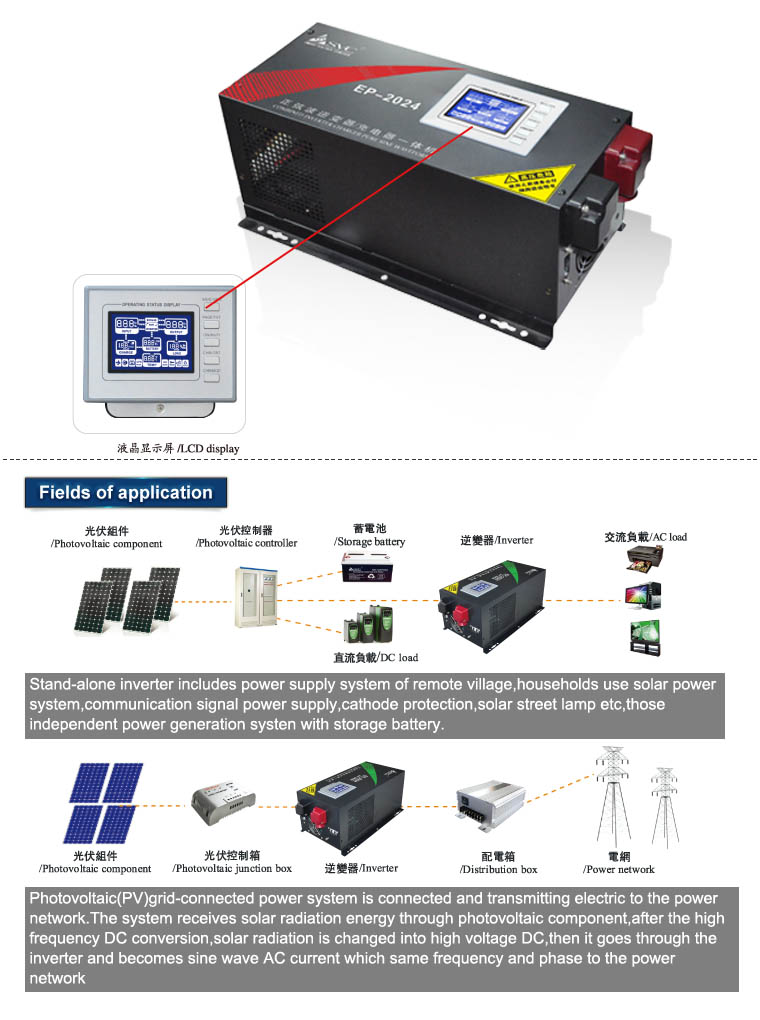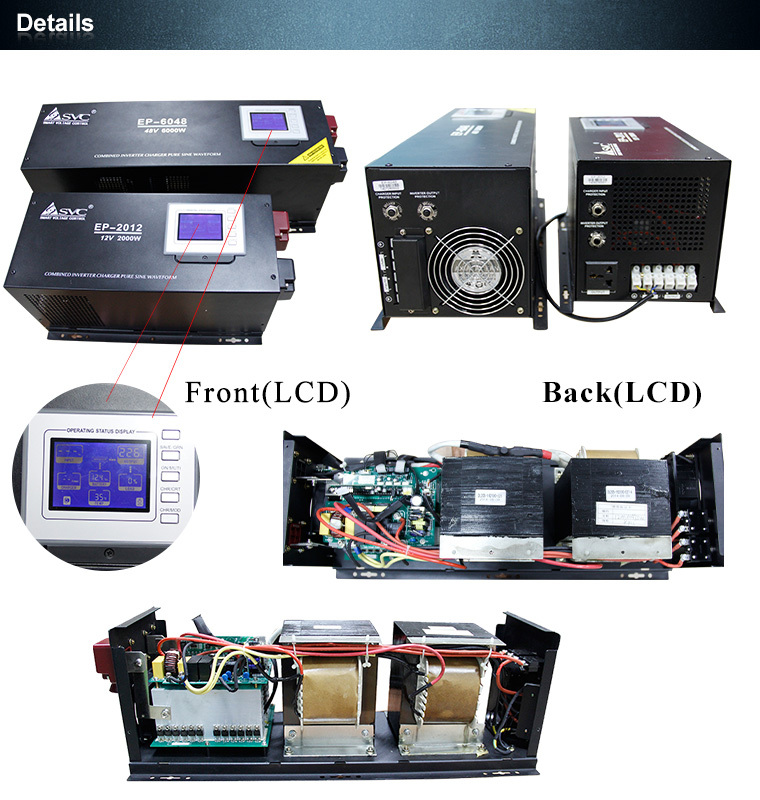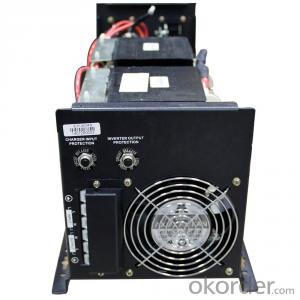Low Frequency Inverter Pure Sine Wave (Remote Control) 1000W 12V 220V Inverter
- Loading Port:
- China main port
- Payment Terms:
- TT OR LC
- Min Order Qty:
- 20 carton
- Supply Capability:
- 10000 carton/month
OKorder Service Pledge
OKorder Financial Service
You Might Also Like
Remote Control Low Frequency Pure Sine Wave 1000W 12V 220V Inverter

Product Description

| Model | EP-1012 | EP-2024 | EP-3024 | EP-4048 | EP-6048 |
| Rated power | 1000W | 2000W | 3000W | 4000W | 6000W |
| INPUT | |||||
| Input voltage range | 185~265VAC | ||||
| OUTPUT | |||||
| Input voltage range | 220VAC/230VAC | ||||
| Output frequency | Batt. Mode:50±0.5Hz Acmode:48~54Hz(50Hz) or 58~64Hz, Same as AC | ||||
| Output wave form | Sine wave (Batt. mode) | ||||
| Transfer time | 10ms(Typical) | ||||
| PROTECTION | |||||
| Overload protection | (100%<Load<120%)±10%:Auto shutdown in 2 mins;(120%<Load<140±10%;Auto shutdown in 60 Secs;(140%<Load)±10%:Auto shutdown in 20 Secs; | ||||
| Output short circuit protection | Yes | ||||
| Breaker | Input:15A/Output:10A | Input:30A / Output:15A | Input:35A / Output:20A | Input:40A / Output:30A | |
| BATTERY | |||||
| Rating charging current(Max.) | 45A | ||||
| Nominal DC input voltage | 12V | 24V | 48V | ||
| 20V/40V | |||||
| PHYSITAL | |||||
| (kg) / Net weight (kg) | 22.8 | 27.6 | 32.4 | 38.2 | 44.5 |
| (mm) / Unit dimention (mm) | 468(L)*224(W)*212(H)mm | 644(L)*224(W)*212(H)mm | |||
| ENVIRONMENT | |||||
| Environment of performance | Temperature 0℃~40℃, Humidity 20%~90% | ||||

Ep series is sine wave low frequency inverter, which is specifically designed for home appliances. It is equipped with a big LCD screen so all information is displayed in detail, which makes it more convenient to use. Charging current of the inverter is adjustable from 5A to 45A and you can also select different charging voltage to charge different types of batteries so batteries are under great protection.
Feature:
1. Suitable for all electrical equipments
2. Large LCD display for more detailed content
3. CPU controlled; fast transfer time
4. Intelligent battery management, prolonging the service life of the battery
5. Complete protection function, high reliability
6. Can provide high current charge
7. Can match different types of batteries
8. Disassembled LCD box which can make the operation in a distance of 15 meters

- Q:Can solar energy systems be used in areas prone to hurricanes or earthquakes?
- Yes, solar energy systems can be used in areas prone to hurricanes or earthquakes. While these areas may experience natural disasters, solar panels are designed to withstand harsh weather conditions. They are securely mounted to withstand high winds and are made of durable materials. Additionally, solar energy systems are decentralized and can provide power even if the grid is disrupted during a hurricane or earthquake.
- Q:Can solar energy systems be connected to the existing power grid?
- Solar energy systems can indeed be linked to the current power grid, known as grid-tied or grid-connected solar systems. In this configuration, solar panels harness sunlight to generate electricity, which is then converted by inverters into usable AC power. This AC power is then integrated into the existing power grid, effectively supplementing the utility company's electricity supply. Grid-tied solar systems provide multiple advantages. Primarily, they allow homeowners and businesses to decrease their dependence on fossil fuel-based electricity and reduce their carbon footprint. Moreover, any surplus electricity generated by the solar panels can be returned to the grid, resulting in net metering or feed-in tariffs. In this scenario, the excess power is credited to the system owner by the utility company, leading to substantial cost savings or even potential revenue generation. Furthermore, grid-tied systems ensure a reliable and consistent supply of electricity. During periods when the solar panels are unable to generate sufficient power, such as at night or during cloudy weather, electricity can be acquired from the grid. Conversely, when the panels produce more electricity than is being utilized, the surplus is sent back to the grid, guaranteeing an uninterrupted and continuous power supply. It is important to acknowledge that the installation and connection of grid-tied solar systems may necessitate the approval and coordination of the local utility company, as well as adherence to pertinent regulations and safety standards. Nevertheless, the capability to connect solar energy systems to the existing power grid renders them a versatile and advantageous renewable energy solution.
- Q:Can a solar energy system be installed on a commercial building?
- A commercial building can indeed have a solar energy system installed. In fact, numerous businesses have embraced solar power as an eco-friendly and cost-effective solution for their energy requirements. By installing a solar energy system on a commercial building, there are several advantages to be gained. These include lower electricity bills, potential tax incentives and rebates, increased property value, and a positive brand image associated with environmental responsibility. Commercial buildings typically possess ample rooftop space, which makes them perfect for the installation of solar panels. Moreover, advancements in solar technology have made it simpler and more efficient to integrate solar systems into commercial buildings. With careful planning and professional installation, a solar energy system can supply clean and renewable energy to power various operations within a commercial building, thereby contributing to a greener and more sustainable future.
- Q:Can solar energy systems be used in powering car charging stations?
- Car charging stations can definitely be powered by solar energy systems. Actually, many car charging stations worldwide already rely on solar energy. Solar panels can be placed on the roof or in close proximity to the charging station, capturing sunlight and converting it into electricity. This renewable energy can then be used to charge electric vehicles (EVs) without depending on the traditional power grid. Solar-powered car charging stations have several advantages. Firstly, they provide a sustainable and clean energy source, reducing carbon emissions and the overall environmental impact of EVs. Secondly, they can be installed in remote or off-grid areas where connecting to the electrical grid may be difficult or costly. This makes solar-powered charging stations especially beneficial for rural regions or highways lacking easy access to electricity. Additionally, solar energy systems can incorporate battery storage, enabling excess energy generated during the day to be stored and utilized during the night or periods of high demand. This guarantees a continuous and reliable power source for car charging stations, even in the absence of sunlight. Although the initial installation cost of solar energy systems may be higher when compared to traditional power sources, their long-term operating and maintenance costs are generally lower. Moreover, there are various government incentives and rebates available to promote the use of renewable energy, which can help offset these initial expenses. All in all, solar energy systems offer a viable and sustainable solution for powering car charging stations, providing environmental benefits, energy independence, and long-term cost savings.
- Q:How does the angle of solar panels affect their efficiency?
- The angle of solar panels significantly affects their efficiency. By adjusting the angle, panels can maximize their exposure to sunlight, ensuring optimal energy absorption. The ideal angle varies depending on the geographical location, time of year, and panel type. A properly adjusted angle can increase the efficiency of solar panels and ultimately enhance their electricity generation.
- Q:Can solar energy systems be used in areas with limited water supply?
- Yes, solar energy systems can be used in areas with limited water supply. Unlike other forms of energy generation such as fossil fuel or nuclear power, solar energy systems do not require water for their operation. Solar panels generate electricity by converting sunlight into energy without the need for water cooling or steam generation, making them ideal for areas where water resources are scarce.
- Q:Can solar energy systems be used in powering retirement homes or assisted living facilities?
- Yes, solar energy systems can definitely be used to power retirement homes or assisted living facilities. Solar panels can be installed on the roofs or in open spaces of these facilities to capture sunlight and convert it into electricity. This renewable energy can then be used to power various amenities such as lighting, heating, cooling, and appliances, reducing their reliance on traditional power sources and lowering energy costs. Additionally, solar energy systems are environmentally friendly and sustainable, aligning with the growing trend of integrating green solutions in retirement homes and assisted living facilities.
- Q:Can solar energy systems be used in rural areas without access to the power grid?
- Yes, solar energy systems can be used in rural areas without access to the power grid. Solar panels can generate electricity from sunlight, which can then be stored in batteries for use during the night or when the sun is not shining. This allows rural areas to have a reliable and sustainable source of electricity without being connected to the power grid.
- Q:Can solar energy systems be used in areas with limited access to maintenance services?
- Yes, solar energy systems can be used in areas with limited access to maintenance services. Solar panels are designed to be durable and require minimal maintenance. They have no moving parts, reducing the need for regular servicing. Additionally, advancements in solar technology have improved the reliability and longevity of these systems. However, occasional maintenance, such as cleaning and inspecting the panels, may still be necessary to ensure optimal performance.
- Q:Do solar energy systems require a backup generator?
- A backup generator is not always needed for solar energy systems. The primary source of power for these systems is sunlight, meaning they can generate electricity as long as there is enough sunlight. It's important to consider that solar energy systems are usually connected to the electrical grid, allowing any surplus power to be sent back to the grid when the solar panels produce more electricity than is being used. This can result in a credit or compensation from the utility company, which can help offset the cost of electricity when the solar panels are not generating enough power. However, if a solar energy system is not connected to the electrical grid and operates independently, a backup generator or an energy storage system like batteries may be necessary to ensure a continuous power supply during periods with insufficient sunlight. Ultimately, the need for a backup generator depends on the specific setup and requirements of the solar energy system.
1. Manufacturer Overview |
|
|---|---|
| Location | |
| Year Established | |
| Annual Output Value | |
| Main Markets | |
| Company Certifications | |
2. Manufacturer Certificates |
|
|---|---|
| a) Certification Name | |
| Range | |
| Reference | |
| Validity Period | |
3. Manufacturer Capability |
|
|---|---|
| a)Trade Capacity | |
| Nearest Port | |
| Export Percentage | |
| No.of Employees in Trade Department | |
| Language Spoken: | |
| b)Factory Information | |
| Factory Size: | |
| No. of Production Lines | |
| Contract Manufacturing | |
| Product Price Range | |
Send your message to us
Low Frequency Inverter Pure Sine Wave (Remote Control) 1000W 12V 220V Inverter
- Loading Port:
- China main port
- Payment Terms:
- TT OR LC
- Min Order Qty:
- 20 carton
- Supply Capability:
- 10000 carton/month
OKorder Service Pledge
OKorder Financial Service
Similar products
New products
Hot products
Hot Searches
Related keywords






























